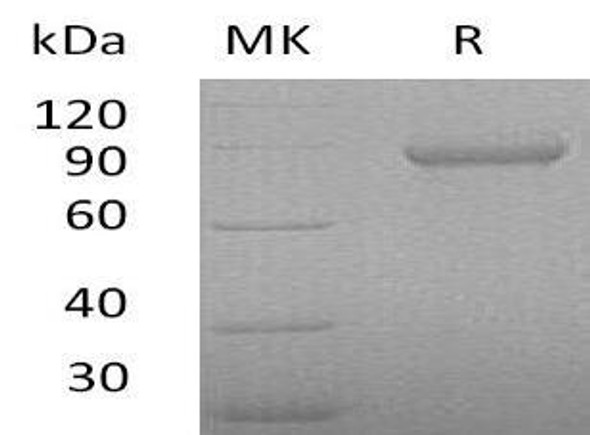Description
| Product Name: | Human Periostin Recombinant Protein |
| Product Code: | RPPB0850 |
| Size: | 10µg |
| Species: | Human |
| Target: | Periostin |
| Synonyms: | OSF-2, Periostin, Osteoblast Specific Factor 2, PN OSF-2, PDLPOSTN, POSTN, MGC119510, MGC119511, PN, RP11-412K4.1. |
| Source: | Escherichia Coli |
| Physical Appearance: | Filtered White lyophilized (freeze-dried) powder. |
| Formulation: | Filtered (0.4 �m) and lyophilized from 0.5 mg/ml in 0.05M Acetate buffer pH-4. |
| Solubility: | It is recommended to add 0.1M Acetate buffer pH4 to prepare a working stock solution of approximately 0.5 mg/ml and let the lyophilized pellet dissolve completely. For conversion into higher pH value, we recommend intensive dilution by relevant buffer to a concentration of 10�g/ml. In higher concentrations the solubility of this antigen is limited. Product is not sterile! Please filter the product by an appropriate sterile filter before using it in the cell culture. |
| Stability: | Store lyophilized protein at -20°C. Aliquot the product after reconstitution to avoid repeated freezing/thawing cycles. Reconstituted protein can be stored at 4°C for a limited period of time; it does not show any change after two weeks at 4°C. |
| Purity: | Greater than 90% as determined by SDS-PAGE. |
| Amino Acid Sequence: | MGHHHHHHHH HHSSGHIEGR HMRNNHYDKI LAHSRIRGRD QGPNVCALQQ ILGTKKKYFS TCKNWYKKSI CGQKTTVLYE CCPGYMRMEG MKGCPAVLPI DHVYGTLGIV GATTTQRYSD ASKLREEIEG KGSFTYFAPS NEAWDNLDSD IRRGLESNVN VELLNALHSH MINKRMLTKD LKNGMIIPSM YNNLGLFINH YPNGVVTVNC ARIIHGNQIA TNGVVHVIDR VLTQIGTSIQ DFIEAEDDLS SFRAAAITSD ILEALGRDGH FTLFAPTNEA FEKLPRGVLE RFMGDKVASEALMKYHILNT LQCSESIMGG AVFETLEGNT IEIGCDGDSI TVNGIKMVNK KDIVTNNGVI HLIDQVLIPD SAKQVIELAG KQQTTFTDLV AQLGLASALR PDGEYTLLAP VNNAFSDDTL SMVQRLLKLI LQNHILKVKV GLNELYNGQI LETIGGKQLR VFVYRTAVCI ENSCMEKGSK QGRNGAIHIF REIIKPAEKS LHEKLKQDKR FSTFLSLLEA ADLKELLTQP GDWTLFVPTN DAFKGMTSEE KEILIRDKNA LQNIILYHLT PGVFIGKGFE PGVTNILKTT QGSKIFLKEV NDTLLVNELK SKESDIMTTN GVIHVVDKLL YPADTPVGND QLLEILNKLI KYIQIKFVRG STFKEIPVTV Y |
Periostin is a disulfide linked 90 kDa, 811 amino acid protein originally isolated as a osteoblast-specific factor that functions as a cell adhesion molecule for preosteoblasts and is thought to be involved in osteoblast recruitment, attachment and spreading. Additionally, periostin expression has previously been shown to be significantly increased by both transforming growth factor beta-1(TGFbeta1) and bone morphogenetic protein (BMP-2). OSF-2 has a typical signal sequence, followed by a cysteine-rich domain, a fourfold repeated domain and a C-terminal domain. The fourfold repeated domain of OSF-2 shows homology with the insect protein fasciclinPeriostin mRNA is expressed in the developing mouse embryonic and fetal heart, and that it is localized to the endocardial cushions that ultimately divide the primitive heart tube into a four-chambered heart.
The OSF2 His-Tagged Fusion Protein Human is produced in E. coli, and its molecular weight is 75 kDa protein containing 648 amino acid residues of the human OSF-2 and 23 additional amino acid residues - HisTag, Xa - cleavage site.
| UniProt Protein Function: | POSTN: Binds to heparin. Induces cell attachment and spreading and plays a role in cell adhesion. May play a role in extracellular matrix mineralization. 4 isoforms of the human protein are produced by alternative splicing. |
| UniProt Protein Details: | Protein type:Motility/polarity/chemotaxis; Cell adhesion; Secreted, signal peptide; Secreted Chromosomal Location of Human Ortholog: 13q13.3 Cellular Component: extracellular matrix; extracellular space; proteinaceous extracellular matrix; trans-Golgi network Molecular Function:heparin binding; protein binding; cell adhesion molecule binding Biological Process: tissue development; extracellular matrix organization and biogenesis; regulation of Notch signaling pathway; cell adhesion; skeletal development |
| NCBI Summary: | This gene encodes a secreted extracellular matrix protein that functions in tissue development and regeneration, including wound healing, and ventricular remodeling following myocardial infarction. The encoded protein binds to integrins to support adhesion and migration of epithelial cells. This protein plays a role in cancer stem cell maintenance and metastasis. Mice lacking this gene exhibit cardiac valve disease, and skeletal and dental defects. Alternative splicing results in multiple transcript variants encoding different isoforms. [provided by RefSeq, Sep 2015] |
| UniProt Code: | Q15063 |
| NCBI GenInfo Identifier: | 93138709 |
| NCBI Gene ID: | 10631 |
| NCBI Accession: | Q15063.2 |
| UniProt Secondary Accession: | Q15063,Q15064, Q29XZ0, Q3KPJ5, Q5VSY5, Q8IZF9, B1ALD8 C0IMJ1, C0IMJ2, C0IMJ4, D2KRH7, F5H628, |
| UniProt Related Accession: | Q15063 |
| Molecular Weight: | 80,357 Da |
| NCBI Full Name: | Periostin |
| NCBI Synonym Full Names: | periostin, osteoblast specific factor |
| NCBI Official Symbol: | POSTN�� |
| NCBI Official Synonym Symbols: | PN; OSF2; OSF-2; PDLPOSTN; periostin�� |
| NCBI Protein Information: | periostin; periodontal ligament-specific periostin; osteoblast specific factor 2 (fasciclin I-like) |
| UniProt Protein Name: | Periostin |
| UniProt Synonym Protein Names: | Osteoblast-specific factor 2; OSF-2 |
| Protein Family: | Periostin |
| UniProt Gene Name: | POSTN�� |
| UniProt Entry Name: | POSTN_HUMAN |









